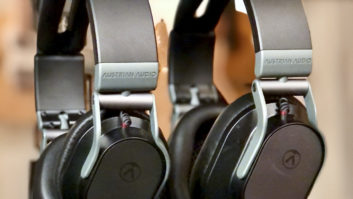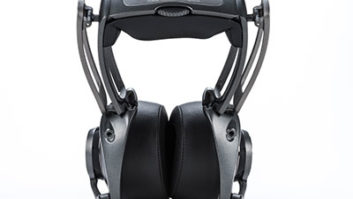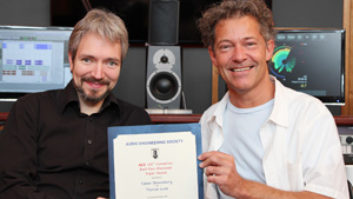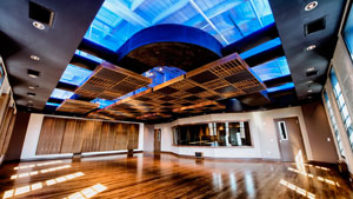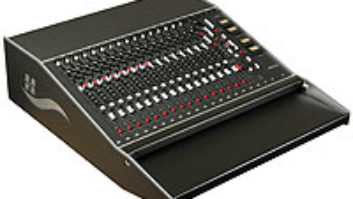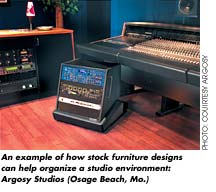
When the idea of a studio is first conceived, the initial discussion
will invariably dwell on the console, recording devices, outboard, DAW,
microphones and acoustics. More astute professionals will go a bit
further, considering ancillary equipment like cabling, mic stands and
patchbays. But what about furniture and ergonomics? Although it may
seem secondary, assigning priority to your space’s shape and vibe can
have a profound impact on the efficiency with which you complete your
projects and contribute to the happiness (and sanity!) of the studio’s
users.
Historically, the recording studio and its equipment were physically
arranged to accommodate technology more so than the humans who operated
it. Think about it: Why in the world would we deliberately design
consoles to have channels 16 feet apart when our arms couldn’t possibly
reach them simultaneously? During the years, we’ve developed
workarounds like automation to help solve these difficulties that we’ve
created for ourselves. Now, the paradigm shift from the traditional
studio to the project studio has yielded the opportunity to redesign
for higher effectiveness.
THE EXPERTS TALK TRENDS
Mix spoke with three leading authorities of studio design and ergonomics
about trends in studio design and how furniture considerations are
increasingly becoming part of the big picture: John Storyk of
Walters-Storyk Design Group, Martin Pilchner of Pilchner Schoustal
Design and Robert Traub of Russ Berger Design Group. According to this
trio, the most prevalent trend at this time is, not surprisingly, the
shift away from traditional large-format consoles to smaller and more
versatile control surfaces.
Storyk says, “My gut tells me that if you start to survey all
studios and all production facilities that are being built, more of
them are going to be using what I call ‘desktop audio’:
smaller-format production and storage devices. That means smaller
physical amounts of equipment and more desire and more ability to have
more interesting furnishing, more interesting ambience, more
interesting client comfort areas, etc. We’ve got studios looking like
homes now.”
According to Traub, “Historically, there were no ergonomics in
the studios. In days of old, it was basically ‘drop the equipment
into a room and work the session.’ Ergonomics and the idea of
being able to adapt to the human form is a relatively new thing that
has been developed not for studio design solely, but in the general
world of furniture design.”
“When you buy a 12-foot-long console,” adds Storyk,
“you pretty much have to put the 12-foot-long console where it
has to go; there’s not much choice. But when your studio is now going
to be an assemblage of computer screens and keyboards and wireless
devices and much smaller rack equipment, there are more choices about
how this equipment should be formally positioned in the room, or
whether it should even be formally positioned in the room. Maybe it
should all be mobile.”
Also supporting this notion, Pilchner adds, “There is also a
need for more interaction between the engineer, producer and artist.
This is achieved by providing flexibility in the control room furniture
and fittings to allow options in spatial relationships that encourage
these types of synergies. Outboard gear, MIDI equipment and keyboards
are incorporated into movable furniture elements that allow them to
break free from their traditional spatial vernacular.”

Traub says, “These rooms are built from the inside out, and we
start with the need and build these rooms to create the floor plan to
create the building that creates the architecture. It’s all such an
interwoven process that even the support furniture, the lounge
furniture and the sofas that support the working environment are
thought of from day one in our office.”
The budget for creating a studio can vary widely, but the underlying
principle remains the same: Focus in on the central purpose of the room
and make the room fit that purpose. As Storyk puts it, “We’re
spending a lot more time as furniture designers than ever
before.” When the budget allows it, custom furniture can
tremendously promote the usability and comfort of a studio. Pilchner
adds, “We usually develop furniture solutions for our clients. We
have found that there are idiosyncrasies particular to each situation
that require a specific design response to achieve real usability.
There are always conflicts between computer keyboards, performance
keyboards and mouse locations, as well as control surface meters,
computer monitors and loudspeaker locations that require a degree of
finesse to make it workable.”
In many instances, “off-the-shelf” solutions are not
flexible enough to accomplish the design goal. Traub says, “I’d
say that 85 percent of the time, we’re designing [furniture] from
scratch. It allows us to support the aesthetic that we’ve already
created for the room, and because we know what the guts of the piece
need to be in order to facilitate the gear in the room, it just makes
it a quicker process for us.”
Another new idea is the elimination of the division between
“control room” and “studio proper.” Pilchner
says, “[The control room] has evolved from its origins as a
‘booth’ to become much more pivotal in the performance
aspect of a recording event, and as such, has become more of a hybrid
production/performance space as compared to its pure-production legacy.
The impact of this, when subjected to usability analysis, implies that
modern control rooms must do many more things well and accommodate more
people. The first evidence of this is that control rooms have become
larger to remain comfortable for more people.” Pilchner Schoustal
recently designed a space in which the traditional
“horseshoe” shape of a MIDI/DAW workstation was literally
turned around backward at the insistence of the client. “They
wanted their clients to be able to gather closely around the center of
creativity. The traditional horseshoe shape envelops and surrounds a
single creator, but turning that shape around backward enables several
people to gather around in close proximity, bringing the clients in
with the professionals. These are the clever new things that are
happening,” says Pilchner.
BASIC CONCEPTS FOR ERGONOMIC ENHANCEMENT
Home studio owners and high-dollar organizations have the same
ergonomic concerns when it comes to their workspace, and can apply the
same basic ergonomic enhancements to improve efficiency and
comfort.
Start with having things in the right places. For example, computer
monitors should be at eye level and lighting should help eliminate
glare and give warm, appropriate visibility. Also, because the tweeters
in your near-field speakers should be at ear level, they often reside
on the same shelf as the computer monitors. Having controls within an
arm’s length is preferable, in addition to installing mixing surfaces
and computer and MIDI keyboards at appropriate (and comfortable)
heights. Frequently tweaked controls should be closest.
The chair should be as posture-friendly as you can afford. Hardware
that’s not supposed to move should be firmly attached so it doesn’t.
Clear and informative labeling of patchbays and other equipment can
dramatically reduce visual fatigue. The “permanent” wiring
of the room should be exactly that — permanent. Wiring
strain-relief eliminates a lot of headaches. Brute-strength grounding
is valuable, and simple things like consistent polarity should not be
overlooked. Climate should be considered, particularly in terms of
temperature consistency. And, finally, a little “vibe” to
promote creativity is nice, as well.
WHERE TO NEXT?
As technology and methodology evolve, so will our studio workspaces.
According to Pilchner, “The future will see continuing changes to
the heart of the production environment, namely the traditional
console. In smaller studios, the console has already been replaced by
control surfaces surrounded by various other production necessities.
This is driving the need for more innovative furniture solutions. The
core of the control room is being defined not only by the means of
control, but also by its ability to embrace new production
realities.” It will be fascinating to see what solutions will
serve these realities.
COMFORT AND EFFICIENCY: SOME OPTIONS
There are quite a few wonderful products that help enhance the
ergonomic studio environment. The following selection of furniture (and
this is by no means an exhaustive list, but rather a few examples) is
equally at home in seven-figure dream rooms and basement studios
alike.
First, I present manufacturers that offer desk, rack, bench and cart
systems that are developed almost exclusively for audio production.
Argosy (www.argosyconsole.com) has an impressive line of
expandable and modular consoles, workstations and racks intended
chiefly for audio. Some are custom-designed for specific consoles, but
others are universal.
Newcomer Jaxon Designs (www.jaxondesigns.com) offers an affordable studio
desk and several slick add-ons made from 9-ply or 12-ply pine or birch.
Especially creative is the custom-made Amp Table that turns a guitar,
bass or keyboard amplifier into a functional and attractive piece of
furniture.
My Dog Rax (www.mydograx.com) offers gorgeous racks for any
studio that requires something a little more aesthetically pleasing.
And although this company’s main focus is on striking racks, it also
presents beautiful consoles and workstations in both
“off-the-shelf” and custom varieties. These products are
truly definitive examples of “studio furniture.”
Omnirax (www.omnirax.com) presents a line of attractive
workstations for keyboards, mixers, audio/video and DAWs, many of them
customized for Pro Tools and its many available control surfaces like
the Mackie HUI. As with other manufacturers, Omnirax provides
workstations that are customized for popular mixers and control
surfaces.
QuikLok (www.quiklok.com) offers an array of high-quality
products centered around stands for keyboards, mixers, mics, speakers
and lighting. Additionally, the company provides high-quality
multi-shelf workstations to serve a number of needs.
Raxxess (www.raxxess.com) has solutions for all issues
associated with rack-mounted equipment, including a huge array of racks
and accessories for the studio and touring, or data and communication
needs, as well.
Finally, Taytrix (www.taytrix.com) is a New York-based organization
that provides not only a range of services including acoustical design,
but also “building blocks for your studio.” Nice custom
racks and cabinets are available, along with things like speaker stands
and gobos.
BEYOND AUDIO APPLICATIONS
There are also a number of manufacturers that develop furniture that
is not necessarily intended exclusively for audio or music production,
but can be easily used that way. The Anthro Corporation (www.anthro.com) has an
extensive line of bench, cart, rack and other systems that tend toward
video editing or multimedia creation, but its “Curved Cart”
can easily accommodate a pair of near-field monitors, a computer
monitor or two, a MIDI controller keyboard, a tower computer and even a
couple of rackmount items.
Another company that develops excellent furniture that’s not just
for audio is Biomorph (www.biodesk.com). It provides a complete line of
“interactive desks,” which enable instant height adjustment
and other modifications. These are tough, welded-steel desks that can
support as many as four or five computer monitors or whatever other
audio hardware you may have.
Middle Atlantic Products (www.middleatlantic.com) offers a line of
customizable and very attractive “edit center systems.”
Once again, these are at home not only in video editing,
post-production and multimedia production, but also very useful for
DAWs and MIDI workstations. These sophisticated desks provide useful
solutions in terms of rackspace.
THE BEST THINGS COME IN LITTLE BOXES
There are lots of “big” considerations in terms of
studio furniture and ergonomics, but the little things are also very
important.
Now that DAWs have become king in the studio environment, the
computer and its peripherals are among the most important
considerations. The venerable mouse, for instance, may very well be the
most handled and used device in the entire room. There is a huge range
of such products available, from the traditional to the exotic, and
there are as many different preferences as there are professionals.
Unfortunately, there is such an array of wonderful control surfaces
and after-market mice, trackballs and drawing tablets that I cannot
cover them all effectively. But I will point out a really powerful
device known as the ShuttlePRO Multimedia Controller from Contour
A/V Solutions (www.contouravs.com). It features a jog knob that
rotates 360° and a spring-loaded shuttle ring that provides seven
variable speeds for scrubbing. It also sports 13 programmable buttons
that can be assigned to any keyboard shortcut or command. Thus, one
hand is given a huge amount of control, while leaving the other hand
available for the computer keyboard or faders, or other controls.
Regardless of your preference, much thought and test-driving should
precede your choice of controller.
There are also little things like monitor mounts that cannot be
truly defined as furniture. Middle Atlantic Products (www.middleatlantic.com) has, for instance, a line
of video monitor mounts that can hold displays from 13 to 37 inches.
They exhibit an elegant design that can accommodate 16- or 24-inch stud
centering, and yield 40° pivot and 355° swivel, so you can
precisely set the viewing angle. This is a great solution if you don’t
have space on your desk for monitors. Likewise, OmniMount (www.omnimount.com),
known for its high-quality speaker mounts, also offers a range of
high-quality video monitor mounts.
Other important considerations along these lines include products
such as anti-glare screens for your monitors or even cleaning products
that can help you keep your space tidy and efficient. Ergonomic
computer keyboards and the like can also help to promote workspace
efficiency. When you go about enhancing your workspace’s ergonomics and
efficiency, don’t forget to consider all of these little things!
John McJunkin is the principal of Avalon Audio Services
(Phoenix).
